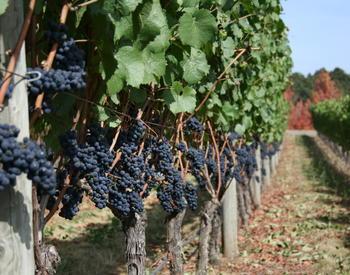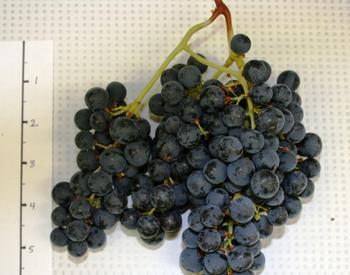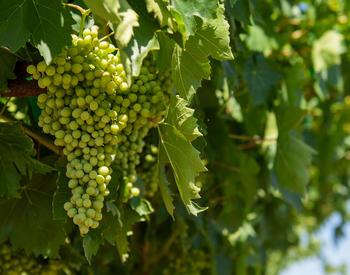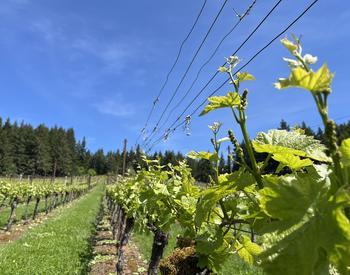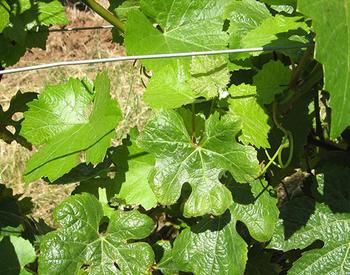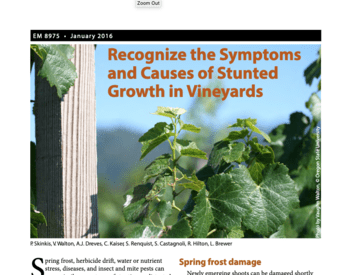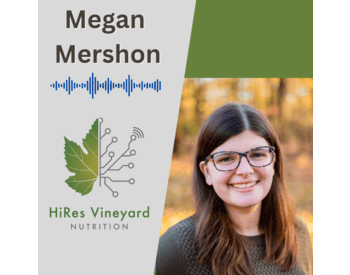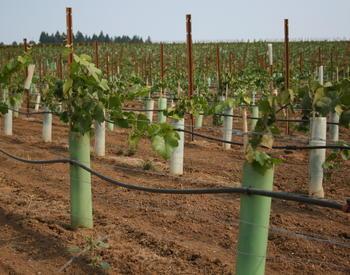Transcript
[Music]
scouting prophylaxis is a critical
component of your vineyard management
plan
it helps with weed and vineyard floor
management
as moving soil from infested blocks
to non-infested blocks can increase the
spread or the risk of spread
of phylloxera it also is going to be
important for planning
on replanting and knowing where to use
root stocks within your vineyard
and lastly it's important to know where
infections are so that other vineyard
tests can be
conducted in a manner that they're done
from non-infected blocks
to infected blocks feeding resembles
drought stress and could seem like
proper deficit irrigation
but these critters are often found in
healthy looking vines
and we'll show you how and where and
when to scout
so a couple things i want to cover today
When to scout
is when and where
to scout for phyloxera the wear is
actually pretty easy
and that's because of those symptoms
that phyloxora can inflict upon the vine
that gwen talked about
it's mostly related to vine vigor
because phyloxor feeds on the roots
that causes the plant to be water
stressed over time and nutrient stress
and all the other things that happen
when a plant has no roots
right so the interesting thing with
phyloxora is
it oftentimes early symptoms are
probably masked
by our regulated deficit irrigation
practices we're already controlling
canopy vigor through a reduction in
water
the problem or what you will likely
notice that hey this is
worse than just regulated deficit
irrigation is when you can no longer
control
the rate at which you are reducing vigor
that's usually a good indicator to maybe
i should look to see if something else
is affecting the vineyard
so the two main things that you're
looking for with in vineyards with
phyloxor really are
a reduction in and vigor in a canopy and
then a
pattern in that reduction in vigor so
then
for vigor simply just look at the canopy
are the shoots long
are they short you can also use imagery
like
ndvi that can help you identify areas or
pockets of potential higher stress
plants within the vineyard and that's an
interesting concept this idea of a
so as gwen indicated phyloxera is a soil
borne root pest right
if you do a lot of movement of equipment
or soil movement within the vineyard
phylloxera will move with it
so because of that if you can think of
how we typically manage within a
vineyard row we're dragging
equipment up and down a row so phyloxora
starts off as a single point
source as we move equipment that
potential infestation
spreads so you will start to see pockets
or oval shaped pockets
of vine stress within your vineyard that
is a great place to
start your scouting practices for
looking to
where phylloxera might be so oval shaped
pockets
of high vine stress or very low vine
vigor
the next question i always get hey
michelle
what gwen when do you actually start
scouting for phyloxera
thank you i have a script right there
right right so
when do you scout for phyloxera which is
a great question by our often peanut
gallery gwen hohizel
so when is actually a pretty good
question to scout because a lot of
people
want to get out there and start scouting
throughout the growing season and
because it's a soil-borne pest
that means you could be doing a lot of
digging for very little output
right actually you may not actually be
able to find the instax insect
the beauty of phylloxera is that it's
pretty temperature sensitive
it doesn't like really cold temperatures
and it doesn't like really hot
temperatures
so the ideal times to scout for this
thing are when soil temperatures are
moderate
so in the early spring and then in the
fall like now
so phylloxera won't start feeding on
roots until the soil itself
is about 64 degrees fahrenheit so you
don't have to start digging much earlier
than that so that's that's pretty nice
the beauty of that too is that's also
when the vine is starting to develop a
canopy
so you may even start to see early
symptoms during that time period
at the end of the growing season once
the soil is starting to cool off a
little bit
that's when you'll see a lot of really
high populations of phyloxor on the
roots so it's easier to see
in the fall but you might be able to do
scouting much earlier than in the early
spring
so in the fall if you can imagine right
before harvest we've probably
done regulated deficit irrigation we're
stressing the vines anyway the vines are
starting to shut down
that's when you can really start to
notice pretty severe canopy symptoms
so it's also easier to identify where to
potentially scout in in the vineyard as
well
so those are the two big things when do
you scout well when the soils are
moderate so in the spring and the fall
and where do you scout you look for
areas in the vineyard that are seemingly
under
high levels of stress that you can't
really explain otherwise
Tools
when you go out to the vineyard you're
going to need a few tools
one is a shovel script not necessary
you're going to need a trowel a pruner
to be able to prune large roots
flagging tape so that you can mark the
vines
that might have infestation and then of
course a hand lens so that you can see
the phylloxera
but if you're like any good entomologist
you might wear these nice oculars
that allow you to look and dig at the
same time
and then lastly you can wear these
fashionable booties to help prevent
spread
they're like masks for your feet so now
that we're suited up
and booted up we can actually start
digging for phyllox syrup
so again when you go into a vineyard and
you you want to potentially
we think about that concept of where we
initially scout we're going to look for
lower vigor sections
like we have here again this is the end
of the season and these uh
these shoots and internodes are not
really that that long
so that's a good place to potentially
start
and the next step we're going to do is
instead of digging out in the middle of
the vineyard row
we're going to dig where there are
grapevined roots because this insect
feeds on grapevine roots so the best
place to look for it
will be where roots should be so let's
let's do some digging here
oh that soil was nice and not
pre-loosened at all
very beautiful
[Applause]
all righty scalpel thank you
so again we're looking for for roots but
this is a little bit concerning
because i just dig dug two big scoop
bowls and i am not finding
many grapevine roots well if you think
about it that would make sense
this canopy is not very vigorous
something clearly has messed
up the the irrigation and water uptake
for this particular plant
and so notice we're digging we're
digging there is a
not a lot of anything right there
except for maybe this little guy other
scalpel
thank you
if we look at this this this is
pretty much the only root piece that we
found in this entire section
uh that's that's not too good notice
there's very little roots
it's actually entirely dead and this is
a very common problem with phylloxera
the feeding itself isn't what kills the
plant but it's all the secondary rot
organisms
that move in once the vine root is
starting to die
so for example we happen to have found
these other root pieces on a severely
impacted plant
and notice that these main roots totally
rotted
dead or dying absolutely no fine root
hairs
you're not going to find phylloxera on a
root that has no root hairs for which
the phylloxera can feed
so even though these really symptomatic
plants
are a good place to start don't be
surprised if you can't find enough
any phyloxora on them so if symptomatic
plants
have a really damaged root system and we
can't find phylloxera
the best place to probably find
phyloxora are on vines that look pretty
healthy
but are nearby the symptomatic plants so
let's go look at some of those
so as we're moving up the vineyard here
you notice
pretty unhealthy vines oh yeah that's a
good one glenn
definitely not what we want to see with
a clear cut
healthy line as you go up the vineyard
it's easy to see
it's very easy to see so very very small
canopies very small canopies and oh
wait what do we see right across the row
here these are some pretty look healthy
looking canopies gwen and it's easy to
think about because
by lotzer can often move up and down a
row absolutely
absolutely so as we go along as we go
along
oh what do you know gwen somebody has
pre-dug a hole for us
in which we can look at grapevine roots
that's the power of extension in your
vineyard
absolutely so let's let's look a little
bit closer
[Applause]
so here we see a bunch of grapevine
roots already in the hole
these roots as you probably already
noticed have a lot more fine root hairs
excellent fantastic or fine fine roots
and honestly
with a healthy vine we even start to
notice some actual active
grapevine phylloxera galls
so here you see these creamy colored
white bulges
that is the root forming a gall as a
result of phylloxera feeding
so the interesting thing here is these
are fresh galls as noted by that fresh
creamy white tissue
but older galls will look pretty similar
to this and honestly look a lot
like dried dark brown mouse droppings on
the plant
so old galls will dry out and die and
those are the ones that look like
mouse droppings fresh galls will be
creamy and white
but again you really only find galls on
plants that have a healthy enough root
system
to support the smaller root or smaller
root growth
if the vine has no roots you will not
find phylloxera
so let's look for some phyloxera itself
so when you're digging up and looking
for phylloxera
they can be sometimes challenging to see
but what you can see
fairly easily with the naked eye is
gold or yellow specks
along the root what that actually
indicates
if you were to look with your hair your
hand lens is
a cluster or a mass of sometimes dozens
of
individual phyloxora laos so if you
looked
with your hand lens you could see many
many individuals
within that one single gold mass
and you can see them sometimes going all
the way up a root
but it is difficult to sometimes see if
you looked at this and you wanted to see
an individual laos because it's only one
millimeter big
and they sometimes change color from
from pale yellow to dark brown and
that can be challenging and sometimes
they hide underneath
little crevices within this bark but
almost with any uh severe infection
you can see these large gold masses
that's your telltale sign to start using
your hand lens and be able to pick up
on clusters of phylox or laos
you
Grape phylloxera is an aphid-like insect pest of grapevines. It exists in vineyards world-wide and was first discovered in Oregon vineyards in the early 1990's. It has more recently been found in the eastern reaches of Oregon and Washington's Walla Walla Valley and other areas of eastern Washington, an area thought to be free of this pest. Most of the vineyards in those regions are own-rooted Vitis vinifera cultivars that are highly susceptible to decline by grape phylloxera. This video presented by Washington State University Extension faculty Dr. Michelle Moyer and Gwen Hoheisel, provides good information and visuals on how to identify phylloxera in infested vineyards of eastern Washington. Keep in mind that there may be some slight differences for observing phylloxera in western regions of Oregon due to soil type and temperature differences. Also, phylloxera is not a concern in vineyards that are planted to resistant rootstocks, which are prevalent in much of western Oregon production regions.
For further information about grape phylloxera, see our OSU Extension Publication:
Grape Phylloxera: Biology and Management in the Pacific Northwest
